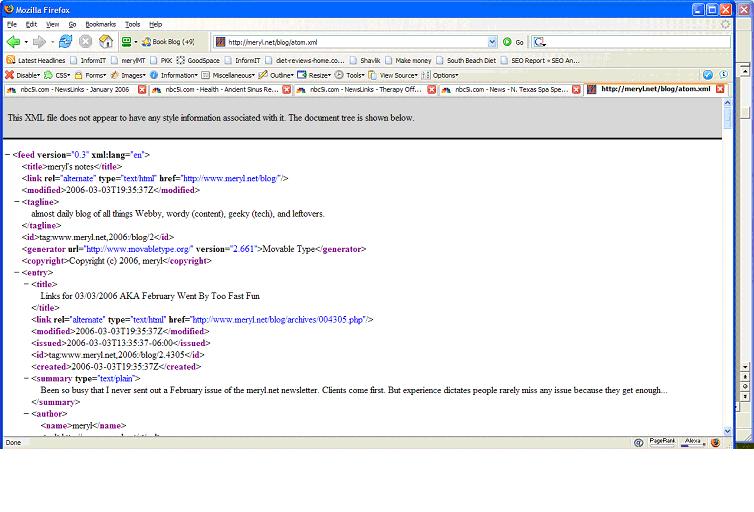Do you prefer to get information from email newsletters? Web sites? Blogs? Feeds? A mix? What about your customers?
| Next Marketing Challenge
Help wanted! Where do you find experienced marketers? |
It's unlikely they all retrieve and read information the same way. A growing number of users are relying on RSS feeds to satisfy their hunger for information.
People who rely on RSS feeds have also discovered that many sites don't update their content very often. So rather than checking the sites for updated info, they let it come to them through the feed reader. Until the site has been updated, the feed reader doesn't fetch anything. In other words, people find a prescription of RSS cures information overload.
RSS: A Quick Introduction
Do you read MarketingProfs online? Have you noticed the orange RSS button on the lower left of the page like the one shown in figure 1? Click it or any orange or blue XML or RDF icon, and you most likely get babble.
 feed
feed
Figure 1: Button and text indicate feed is available
Some places use "Feed," "Syndicate this site" or "RSS Feed," which also provides a link to a feed. The feed is unreadable because it has Figure 2: The bare bones of a feed "RSS" stands for rich site summary and really simple syndication. RDF is resource description framework. XML is extensible markup language. This is all Greek to most people, and we need an interpreter to translate it into readable text. These translators are known as aggregators, feed readers, news readers, and news aggregators. They make the content readable by converting the Marketing Side Effects Fans of aggregators have admitted they won't read a Web site's content unless it has an RSS feed available. They prefer doing most of their reading within the RSS reader. It's faster to read content from 50 Web sites within the aggregator as opposed to jumping from site to site, searching for content. You may have lost email newsletter subscribers because they got fed up with email's side effect—spam. Either that, or they don't see the newsletter because it gets diverted into the trash where spam goes. However, this doesn't mean email newsletters should be dropped from the marketing mix. Many still prefer them because the newsletters come to them as opposed to having to open an aggregator to read emails. Many people are also more comfortable with email than with an aggregator. Then again, many people have different tastes. For example, how many different ways can you buy soda? In a can. In a plastic bottle. In a glass bottle. From a fountain. In the same way that soda manufacturers provide multiple options to satisfy different types of customers, offering email newsletters along with RSS feeds helps businesses reach the widest audience possible. That means using multiple methods to disburse content that fits the business's model, including blogs, forums, email newsletters, Web sites, and RSS feeds. Multiple content-delivery methods also get better search engine rankings, receive new traffic through feeds, RSS directories and content aggregators, and syndicate your content to other Web sites. Using multiple methods also improves your content's chances of arriving safely to its audience. Marketers love feed readers, because those who use them want updates from their sites. Therefore, RSS is an important tool to include in marketing's bag of tricks. The more tools you have, the wider the audience you reach. What marketer can ask for anything more? Next Marketing Challenge: Can You Help?
Help Wanted: Where are the experienced freelance marketers?
I recently was hired as the marketing director of a small manufacturing company. I have two other marketers on my staff, but in order to accomplish everything the CEO wants to do, I need to periodically hire additional contract marketers or vendors.
In my last job, I had a regular stable of people who attended staff tradeshows, wrote and designed brochures and direct mail campaigns, responded personally to emails from existing online marketing campaigns, and so on. But I'm in another city now and am not sure where to turn for help. The previous marketing director left on poor terms, and I'd be embarrassed to ask the CEO. Where's the best place to find experienced marketing help at a reasonable rate—either budgeting per hour or per project?
—Tamiel, Marketing Director
If you have a situation or a question needing a few hundred brains for ideas, 180,000 MarketingProfs readers are ready to deliver their thoughts to resolve your challenge. Share your question and you'll get a chance to win a complimentary copy of our book, A Marketer's Guide to e-Newsletter Publishing.




